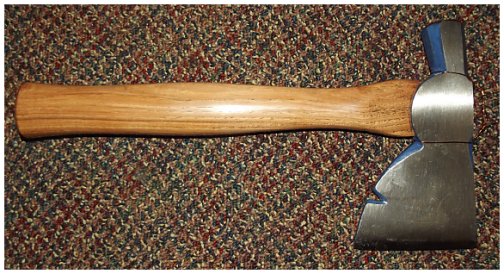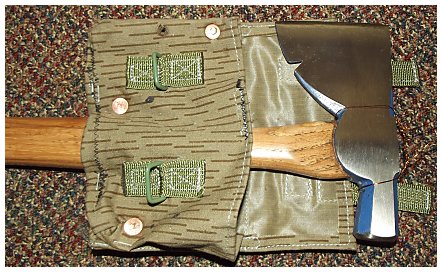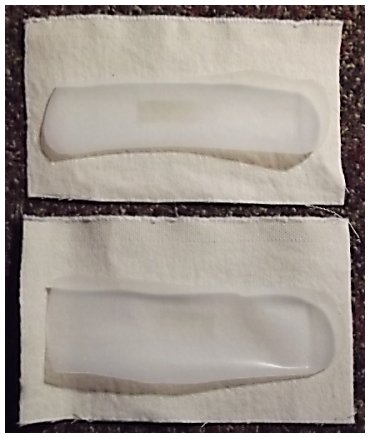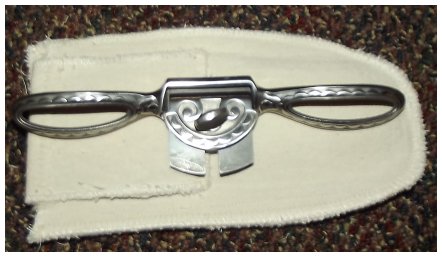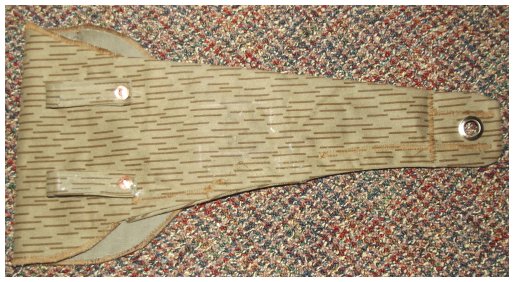|
SITE
INDEX
QUICKENING
NEWS
PREPARATIONS
1.
Food
2.
Manna
Meals
3.
Water
4.
Sanitation
5.
Medical,
health
6.
Kerosene heaters and cookers
7.
Lighting
8. Wood
cooking and heating
9. Communi-cations
10. Essential
Tools
11. Home
built items
12.
Electrical; generators
and power
13. War
preparedness
14.
Gardening
SITE
INDEX
Miles Stair's SURVIVAL
SHOP
HOME
RADIATION
INDEX & JET STREAM
PROPHECY
COMMENTARY
BY MILES
BOOKLETS
BY MILES
GUEST
SUBMISSIONS
PHOTO
INDEX
LINKS
SITE
INDEX
Miles Stair's SURVIVAL
SHOP
|
|
Making Sheathes
for Tools
Tools need to be kept sharp and rust-free so
they are ready to use when needed. That especially
applies to tools saved and stored to be used in an emergency
situation.
Sheathes for small tools
allows them to be carried on a tool belt, the tools being
selected for the particular job at hand. Sheathes for
larger tools allow the tools to be safely strapped to carts
and packs while covering sharp edges to enhance safety.
Sheathes can be made
from a variety of materials such as old Levi's, scrap leather,
cheap East German packs and even PCV pipe and barrels.
The sheathes illustrated
below are ones I made to fit specific tools with materials
close at hand. No attempt was made to make the sheathes
fancy because they are for working TOOLS, not arm chair
theorists to show off something they would never use.
Amost all of these tools
can be purchased inexpensively on eBay, often in very good
condition. They need only be cleaned, oiled and
sharpened to put back into service.
Click on the photos to
enhance them.
BERNARD PLIERS
|
Bernard
pliers were perhaps the first readily available
multi-tools. These pliers were patented July 19,
1892 and are still excellent tools. The flat, parallel opening jaws with compound
leverage applied massive clamping power and the
side-cutters were very powerful for cutting tempered fence
wire. These pliers were carried by farmers and
ranchers on a daily basis for decades. There is a
groove in the middle of the top jaw that straightens wire,
and the design of the compound leverage allows wire to
pass between the handles. |
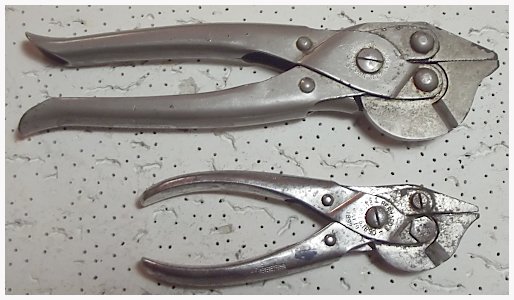 |
SHEATHES FOR BERNARD PLIERS
|
Different
techniques had to be used for making the sheathes for the
large and small Bernard Pliers due to the weight of the
pliers. Notice that not only are the large pliers
longer but they are considerable thicker. |
 |
Small Bernard Plier Sheath
|
The small Bernard Pliers were easy to make a
sheath for using a strip from a pant leg from worn out
Levi's. The back side of the sheath at right shows
the sewn on belt loop. The bottom of the sheath was
doubled Levi canvas, which has more than enough strength
to hold the 6 1/2 ounce pliers. |
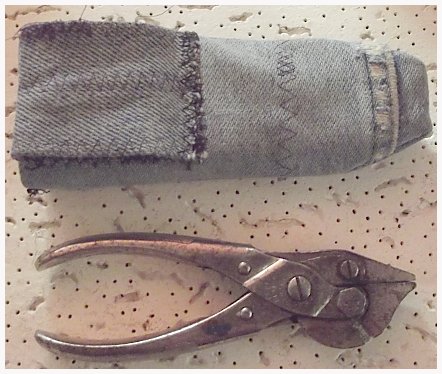 |
|
The front side of the sheath for the small
pliers shows the Levi button to hold the sheath closed.
These buttons are very easy to install and work well for
thick canvas and even inner tube rubber. They are
sold as ''batchelor buttons," "Logger buttons,"
Suspender buttons," etc. |
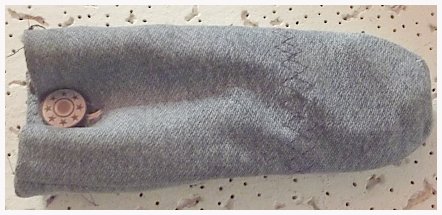 |
Large Bernard Plier Sheath
|
The large Bernard Pliers weigh 1 pound, 3
ounces, so much that they would quickly ''worry'' their
way through Levi canvas in a very short period of time.
Hence, a plastic insert was needed to place inside the
sheath to hold the weight and sharp edges of the pliers.
An 8 fl oz Ronson lighter fluid bottle proved to be an
outstanding fit for the pliers, holding the pliers so they
would not rattle and firmly enough so there is no stress
at all on the old Levi cloth. The back of the
sheath is shown. |
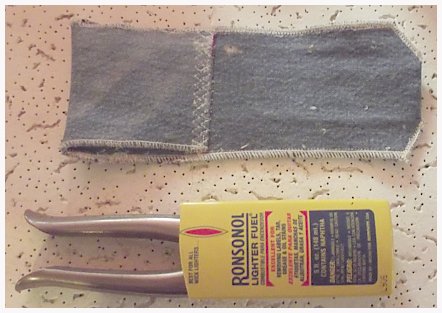 |
|
At right is
the finished sheath for the large Bernard pliers.
The belt loop is full width and supports the weight of
these pliers easily. The sheath was made so that the
handles protrude slightly to ease pulling them from the
sheath for use. |
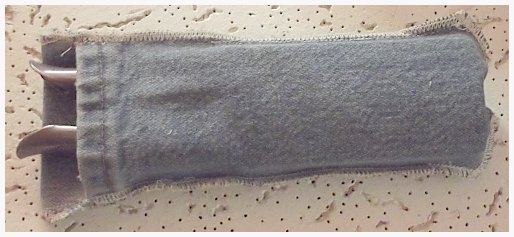 |
HATCHET
A good framing hatchet can be
extremely useful, particularly around a wilderness camp as
they usually have much better steel then a cheap camp
hatchet and nice broad cutting edge.
The left photo above shows my refinished framing hatchet.
But to keep the hatchet sharp and in perfect condition, a
good sheath is required. I used an East German
grenade pouch and some rivets to make the sheath shown
above. The grenade pouch was less than $3.00 from Sportsmansguide.com.
SMALL ADZE
|
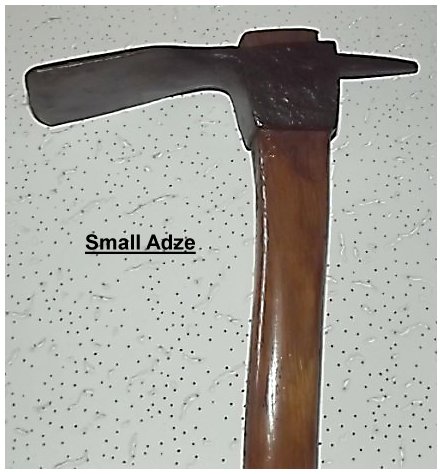 |
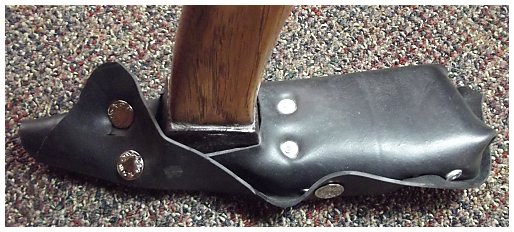
Small
adze in sheath made from a truck inner tube. A
plastic bottle was cut and pop riveted in to cover the
sharp blade edge (right, above). Jeans buttons keep it
closed. |
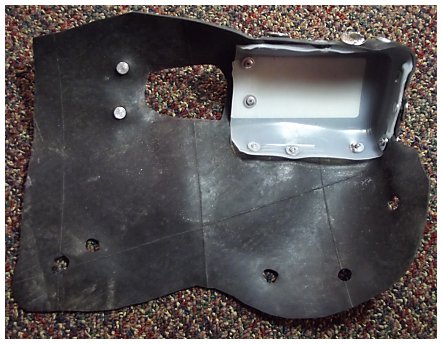 |
A small adze is extremely
useful for shelter building. The sideways edge keeps
your knuckles away from the surface compared to an axe.
They work extremely well for smoothing log surfaces in
confined areas such as the inside of an expedient shelter
(dugout) and for logs which make up the roof of the shelter.
If a shelter is to be rain- and wind-proof, it must be
sealed. The easiest way to accomplish that is to use
an adze to chop off high spots, smooth down branch roots,
and make notches so the logs are interlocked. The
roof is then covered with a few inches of dirt and the
soil smoothed out. A very fine film of plastic sheet
can be carefully laid out over the soil and then be
covered with a few more inches of soil and sod. That thin
film of plastic sheet is the wind and rain protection for
the shelter, and being sandwiched between layers of sod
has automatic UV protection so it will last for years.
Sharp projections having been eliminated by the adze, the
soil protects the delicate plastic film while holding it
in place. The logs on the sides of a shelter should
be chinked with moss (or whatever is available), for which
the back of the adze has been designed. Shelters
such as a dugout should have a plastic film placed on the
outside of the logs before backfilling with dirt. If
smoothed with the adze there should be few sharp
projections to cut the plastic film, but there will still
be some holes. Nevertheless it is far better
moisture protection than nothing at all. Google "Ziemlanka"
for more images of traditional dugouts.
BELT SHEATH FOR SPOKESHAVE
Above left, inserts cut from a
gallon milk jug. These are then sandwiched between
two layers of canvas and each half sewn. The halves
are combined (center photo) by sewing, the trimmed to
final shape and the edges thoroughly sewn with a Zig-Zag
stitch. The end result (right photo above) is a nice belt
sheath for a spokeshave!
BELT SHEATH FOR A
LARGE PELLET PISTOL
A very inexpensive East German Day Pack gave its life to
make the holster shown above for a Daisy Avanti Powerline
747 pellet pistol. This material was too thick to
sew in multiple thicknesses, so I riveted on the belt loops
using common copper rivets. The clasp in front was
liberated from an East German grenade pouch. Because this
pistol is so long, I put a gromet at the bottom of the holster
so it could be tied to a pack or cart.
Wood Augers
|
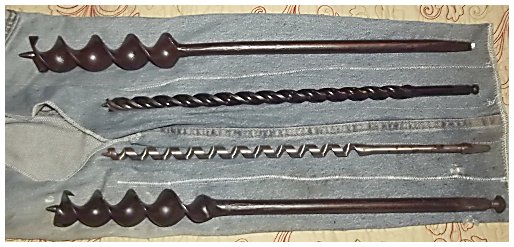 |
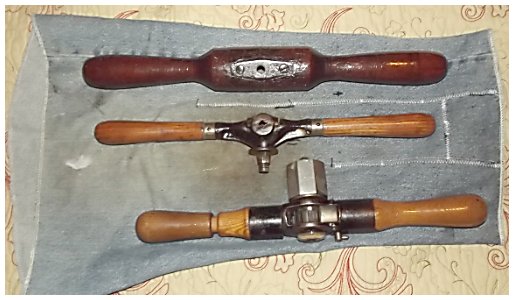 |
|
Pant legs from
an old pair of Levi's sewn to make a sheath to keep the
auger bits secure in storage. When stored like this
the cutting edges don't get banged around and stay sharp
and clean. |
Part of a leg
from old Levi pants for storing the auger handles so they
are always clean, rust free and ready to use. |
DRAW KNIVES
|
 |
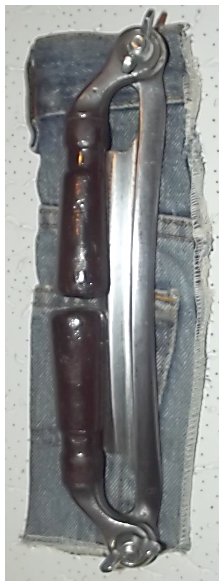 |
| Draw knives
are used to remove bark and to shape logs, make flats on
logs, etc. The 6" draw knife is very handy to carry
and use when needed, but the handles are too close
together for working large logs and thus can cause real
knuckle bruising. There IS a use for large
fixed-handle draw knives, but for little jobs like tool
handles and small logs, these work fine. |
This shows why
I like folding handle draw knives - a sheath can hold one
right on a tool belt. |
KNIVES
|
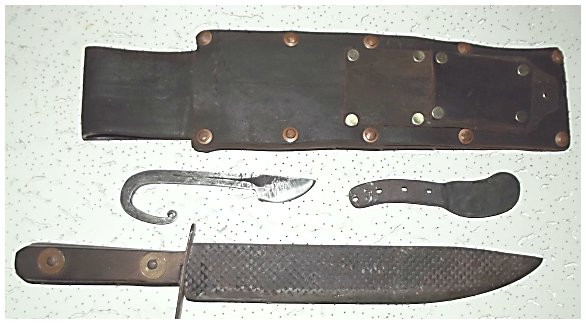 |
 |
| Three knives
hand forged from old files. The handles were made
from dry hardwood found in the forest, shaped and riveted
in place using nails for rivets and copper pennies as
washers. |
The leather
for the sheath was from an old tractor implement power
belt found in an abandoned barn, hand riveted so the
knives all nest as shown above. The cost? Some
nails, rivets, and pennies. |
Custom knife hand forged
from an old file
|
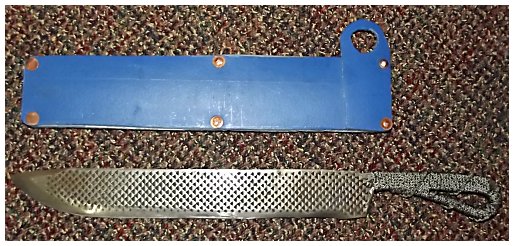 |
 |
|
The knife and
sheath above illustrate that an outstanding and very
useful knife can be made with materials at hand.
A large file was annealed twice, hand forged to shape,
ground, sharpened, then hardened in a two-step
process, the back of the blade being spring temper and
the edge only being knife hard. The knife can
thus be used as a machete, clearing brush and chopping
down small trees, or be a fine combat knife if called
upon to do so. The sheath was made from plastic
cut from a thick blue 50 gallon barrel, glued and
riveted together. If the blade is kept clean and
oiled so that it does not rust, the knife and sheath
should last for the remainder of my lifetime and
another as well. This knife and sheath was made
for me by Chip Delyria. |
SHOVELS
|
The photo
at right shows a sheath I made for a medium sized camp
shovel using rubber from a truck inner tube. The
sheath was simply cut to fit using surgical shears,
then the sides pop riveted with washer backing to hold
the rubber securely. "Logger buttons" (suspender
buttons) were used to hold the cover flap closed. |
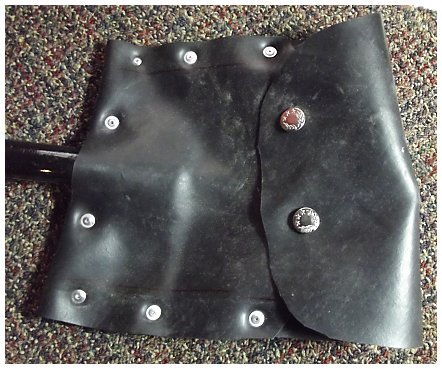 |
RELATED PAGES >
SHELTER
Cabin Building
Without Nails
CARPENTRY TOOLS FOR REPAIR AND CONSTRUCTION
Tools - Restoration
and Rebuilding
|
|
|







